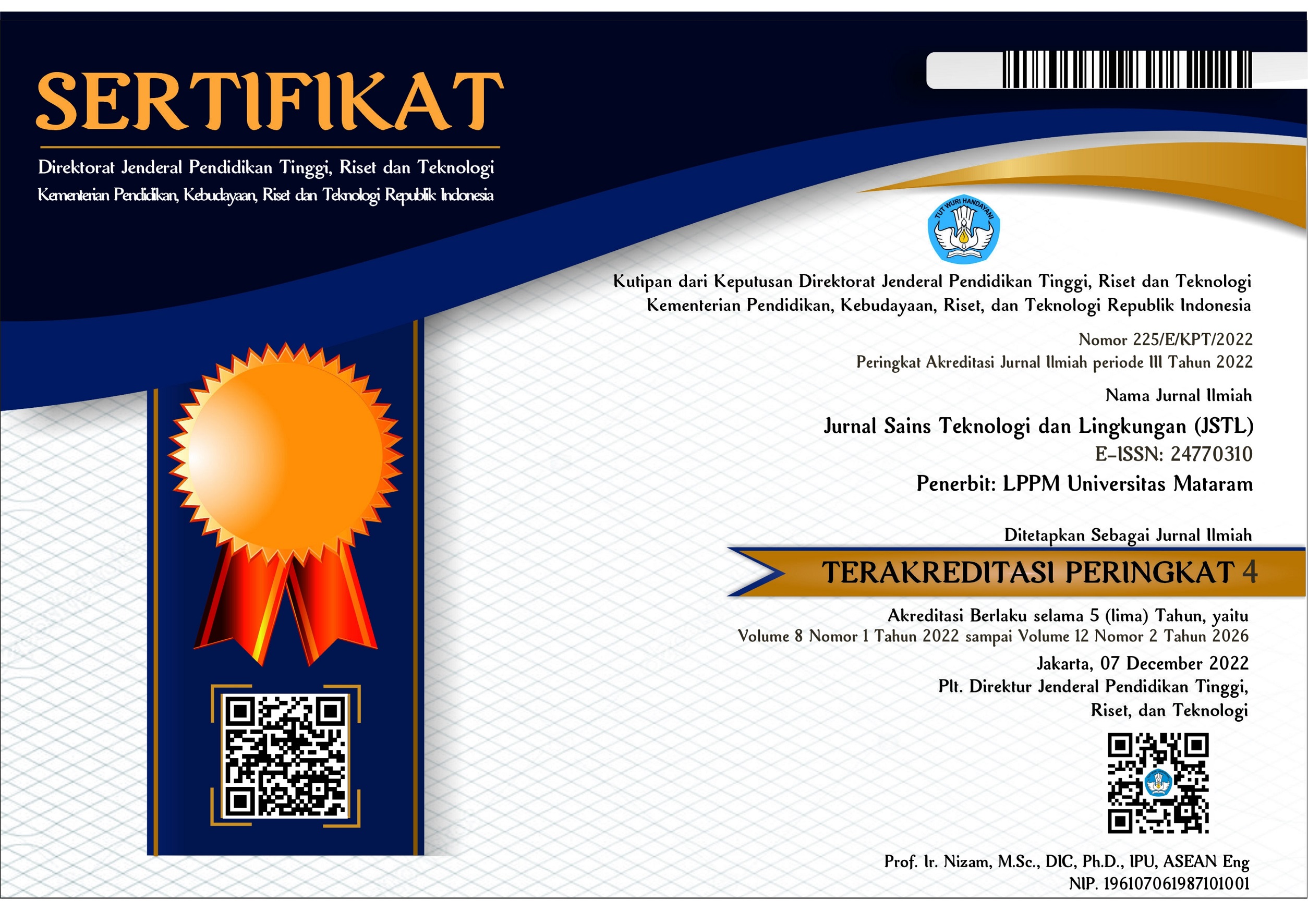Komparasi Metode Titrimetri Dengan Spektrofotometri UV-Vis pada Analisis Chemical Oxygen Demand (COD) Output IPAL Domestik Berdasarkan Linieritas, Akurasi dan Presisi
Comparison Of Titrimetric With UV-Vis Spectrophotometry Methods For The Analysis Of Chemical Oxygen Demand (COD) Output Domestic IPAL Based On Linierity, Accuracy and Precision
DOI:
https://doi.org/10.29303/jstl.v9i4.416Keywords:
domestic waste, COD, titrimetric method, spectrophotometric method, linearity, accuracy, precisionAbstract
The method of a test must be evaluated and tested to ensure that the method is capable of producing valid data. So that validation needs to be done as a quality control that provides assurance that the measurements and results obtained are reliable. This study aims to determine the value and comparison of the values of linearity, accuracy, and precision of the titrimetric and spectrophotometric methods in COD analysis. Determination of the COD value for the titrimetric method was carried out by redox titration using a solution of Ferro Ammonium Sulphate (FAS). While the spectrophotometric method was carried out using UV-Vis spectrophotometry at a wavelength of 420 nm. The research results obtained a linear regression value for the titrimetric method of 0.9989, while the spectrophotometric method was 0.9991, this indicates that the linear regression value of the spectrophotometric method is better than the titrimetric method. The results of the accuracy analysis for the titrimetric method obtained a value of 111.48%, while for the spectrophotometric method it was 103.11%, this shows that the accuracy value of the spectrophotometric method is better than the titrimetric method. The precision analysis results for the titrimetric method obtained a value of 1.77%, while for the spectrophotometric method it was 1.55%, this shows that the spectrophotometric method has a better precision value than the titrimetric method. Based on the comparison of the results of statistical validation using the T-test, there was no significant difference in data between the titrimetric method and the spectrophotometric method.References
Alam, T. 2010. Estimation of Chemical Oxygen Demand in WasteWater Using UV-Vis Spectroscopy. Bangladesh.
Alaerts, G. dan Santika, S.S. 1984. Metoda Penelitian Air. Surabaya: Usaha Nasional.
APVMA. 2004. Guidelines for the Validation of Analytical Methods for Active Constituent, Agricultural and Venterinary Chemical Product. Australia: Kingston APVMA.
Buscio V., Crespi M., and Bouzan C.G. 2014. A Critical Comparison of Methods for the Analysis of Indigo in Dyeing Liquors and Effluents, Materials, ISSN 1996-1944.
Chenxi Wang, Wanxiang Li, and Meizhen Huang. 2019. High precision wide range online chemical oxygen demand measurement method based on ultraviolet absorption spectroscopy and full-spectrum data analysis. https://doi.org/10.1016/j.snb.2019.126943.
Dan Wu, Yinglu Hu, and Ying Liu. 2021. A Review of Detection Techniques for Chemical Oxygen Demand in Wastewater. American Journal of Biochemistry and Biotechnology 2022, 18 (1): 23.32.
Gnanavelu A, Shanmuganathan TS, Deepesh V, and Suresh S. 2021. Validation of a Modified Procedure for the determination of Chemical Oxygen Demand using standard dichromate method in industrial wastewater samples with high calcium chloride content. Indian Journal of Science and Technology 14(29): 2391-2399. https://doi.org/ 10.17485/IJST/v14i29.1412.
Guoqing Wu, W. B. 2011. Determination of Chemical Oxygen Demand in Water Using Near-infrared Transmission and UV Absorbance Method. Chiese Optics Letters, 09(s1).
Harjadi, W. 1986. Ilmu Kimia Analitik Dasar. Jakarta: Penerbit PT Gramedia.
Harmita. 2004. Review Artikel Petunjuk Pelaksanaan Validasi Metode dan Cara Perhitungannya. Jurnal Majalah Ilmu Kefarmasian, 1(3), 117-135.
International Conference on Harmonisation/ICH. 1994. Validation of Analytical Procedures: Text and Methodology Q2(R1). ICH Harmonised Tripartite Guideline, 2(1): 6.
Magnusson, B. and Örnemark, U. 2014. Eurachem Guide: The Fitness for Purpose of Analytical Methods – A Laboratory Guide to Method Validation and Related Topics, (2nd ed. 2014). ISBN 978-91-87461-59-0. Available from www.eurachem.org.
Mark, S. K. 1996. Laboratory Statistics (3th edition). Missouri: Mosby Year Book.
Nurhadi, A. 2012. Modul Pelatihan Validasi Metode Uji. Bogor: AN Training.
Pratiwi, D. E. 2010. Efektivitas Instalasi Pengolahan Air Limbah dalam Penurunan Kadar Chemical Oxygen Demand (COD) di Instalasi Pengolahan Air Limbah Mojosongo Kota Surakarta.
Riyanto. 2014. Validasi & Verifikasi Metode Uji sesuai dengan ISO/IEC 17025 Laboratorium Pengujian dan Kalibrasi. Yogyakarta: Deepublish.
Siregar, S. 2005. Instalasi Pengolahan Air Limbah. Yogyakarta: Kanisius.
Standar Internasional ISO/IEC 17025 (Versi Bahasa Indonesia) tentang Persyaratan Umum Kompetensi Laboratorium Pengujian dan Laboratorium Kalibrasi. 2005: KAN.
Standar Nasional Indonesia 6989.2:2009 tentang Air dan Air Limbah - Bagian 2: Cara Uji Kebutuhan Oksigen Kimiawi (Chemical Oxygen Demand/COD) dengan Refluks Tertutup secara Spektrofotometri. 2009: BSN.
Standar Nasional Indonesia 6989.59:2008 tentang Metoda Pengambilan Contoh Air Limbah. 2008: BSN.
Standar Nasional Indonesia 6989.73:2009 tentang Air dan Air Limbah - Bagian 73: Cara Uji Kebutuhan Oksigen Kimiawi (Chemical Oxygen Demand/COD) dengan Refluks Tertutup secara Titrimetri. 2009: BSN.
Vogel. 1994. Buku Ajar Kimia Analisa Kuantitatif Anorganik (Edisi Keempat ed.). Jakarta: Penerbit Buku Kedokteran, EGC.
Waluya, L. 2001. Bioremidiasi Limbah Domestik Ramah Lingkungan di Kota Malang: Suatu Upaya Mengatasi Pencemaran Kawasan Padat Huni.
Wardhana, W. 2001. Dampak Pencemaran Lingkungan. Yogyakarta: Penerbit Andi.
Wenclawiak, B. 2010. Quality Assurance in Analytical Chemistry: Training and Teaching. Heidelberg: Springer.
Widhiarso, W., dan Suhapti, R. 2009. Eksplorasi karakteristik item skala psikologis yang rentan terhadap tipuan respon. Jurnal Psikologi, 36(1), 73-91.
Downloads
Published
Issue
Section
License

This work is licensed under a Creative Commons Attribution-NonCommercial-ShareAlike 4.0 International License.



1.png)











